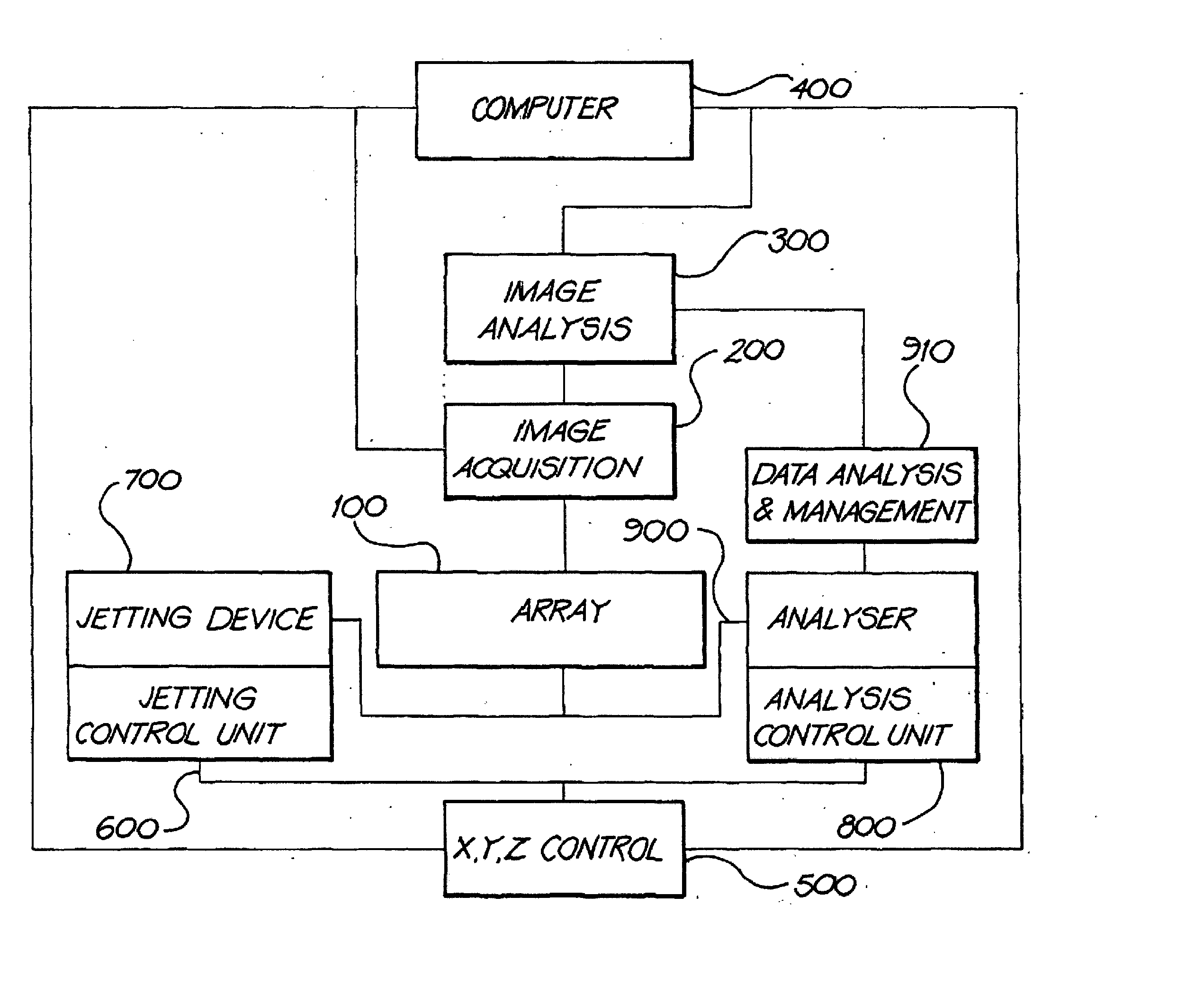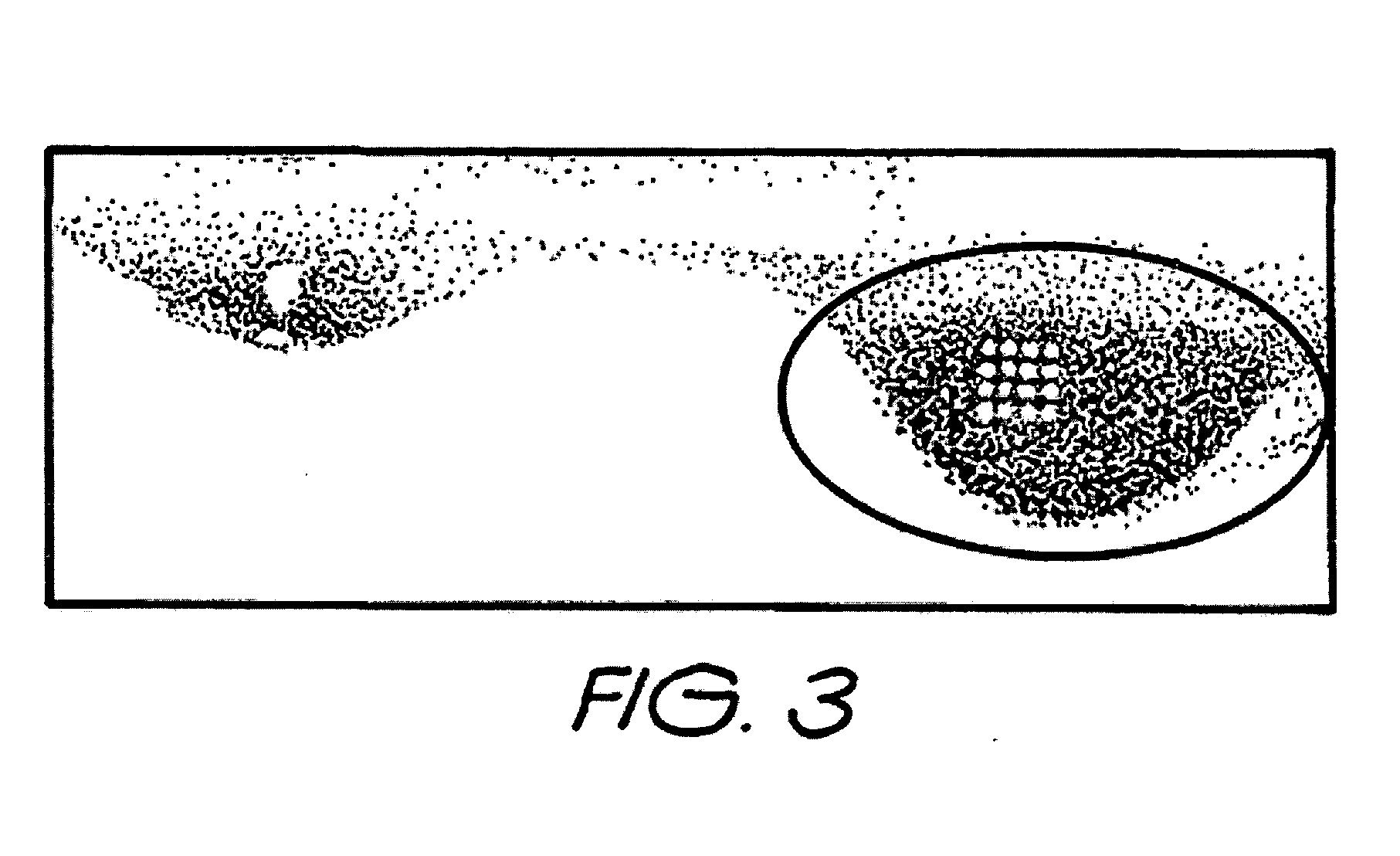Array-based biomolecule analysis
a biomolecule and array technology, applied in the field of biomolecule samples analysis, can solve the problems of existing protein chips, less robust proteins than dna, fragile and denatured, and difficult to lay down antibodies or other protein capture agents, and achieve high density arrays, preserve post-translational modifications, and ensure the effect of stability
- Summary
- Abstract
- Description
- Claims
- Application Information
AI Technical Summary
Benefits of technology
Problems solved by technology
Method used
Image
Examples
example 1
[0085] The aim of this example was to develop chemical printing technology for micro-dispensing human serum that is either seronegative or seropositive for Mycobacterium tuberculosis (TB) as an approach for defining patient immunoreactivity for TB using a purified TB antigen on a nitrocellulose matrix. It will be appreciated that this approach could be used for defining patient immunoreactivity to a number of conditions or diseases by using appropriate antigens.
[0086] Materials and Methods 1.1
[0087] Human serum isolated from two patients, one seronegative and the other seropositive for TB, was diluted 1 in 10 using PBS, pH 7.4+0.05% (w / v) sodium azide +0.1% (v / v) Tween-20 (PBS wash buffer (PBS-WB)) and then filtered through a 0.22 μm syringe filter (Millipore, Danvers, Mass.). Four microlitres of a 370 μg / ml solution of purified 38 kDa TB antigen in PBS, pH 7.4 were applied onto a nitrocellulose membrane (Bio-Rad, Hercules, Calif.) and then allowed to dry. Non-specific binding sit...
example 2
[0091] The development of chemical printing technology for micro-dispensing human serum that is either seronegative or seropositive for Mycobacterium tuberculosis (TB) as an approach for defining patient immunoreactivity for TB using a purified TB antigen subjected to SDS-PAGE and electrotransferrance to nitrocellulose with / without subsequent Direct Blue staining.
[0092] Materials and Methods 2
[0093] 14.8 μg of 38 kDa TB antigen were diluted to 200 μl using ×1 SDS-PAGE non-reducing sample buffer. Sample was then analysed by SDS-PAGE (1.48 μg of antigen per lane) using a 4-12% (w / v) Tris-Bis polyacrylamide gradient gel (Invitrogen, Carlsbad, Calif.) followed by electrotransferrance to nitrocellulose. Two lanes of the blot were visualised using Direct Blue stain (FIG. 3) whilst the other two lanes were not stained. Both blots were allowed to dry at room temperature and were subsequently blocked with 0.5% (w / v) casein in PBS-WB for 15 min. Both blots were then rinsed with PBS-WB and a...
example 3
[0096] This example concerns the application of enzymes to proteins on an array prior to matrix assisted laser desorption ionisation (MALDI) analysis of the fragmented protein in a mass spectrometer. As is known, different enzymes cleave proteins at different amino acid sites. Some enzymes such as LysC, AspN, ArgC cleave at only one specific amino acid site. This is a problem in MALDI analysis as it produces a few large fragments which tends not to produce a very informative spectrum. Other enzymes such as pepsin and chymotrypsin cleave proteins at many amino acid sites. Use of these enzymes prior to MALDI analysis is also problematic as too many small fragments are produced which produces a large number of very small peaks in the spectrum which are very difficult to interpret. Trypsin and GluC cleave at two amino acid sites and this tends to produce good spectra for analysis and thus are the enzymes of choice in MALDI analysis.
[0097] Even so, because these enzymes only cleave at s...
PUM
| Property | Measurement | Unit |
|---|---|---|
| diameter | aaaaa | aaaaa |
| diameter | aaaaa | aaaaa |
| diameter | aaaaa | aaaaa |
Abstract
Description
Claims
Application Information
 Login to View More
Login to View More - R&D
- Intellectual Property
- Life Sciences
- Materials
- Tech Scout
- Unparalleled Data Quality
- Higher Quality Content
- 60% Fewer Hallucinations
Browse by: Latest US Patents, China's latest patents, Technical Efficacy Thesaurus, Application Domain, Technology Topic, Popular Technical Reports.
© 2025 PatSnap. All rights reserved.Legal|Privacy policy|Modern Slavery Act Transparency Statement|Sitemap|About US| Contact US: help@patsnap.com



